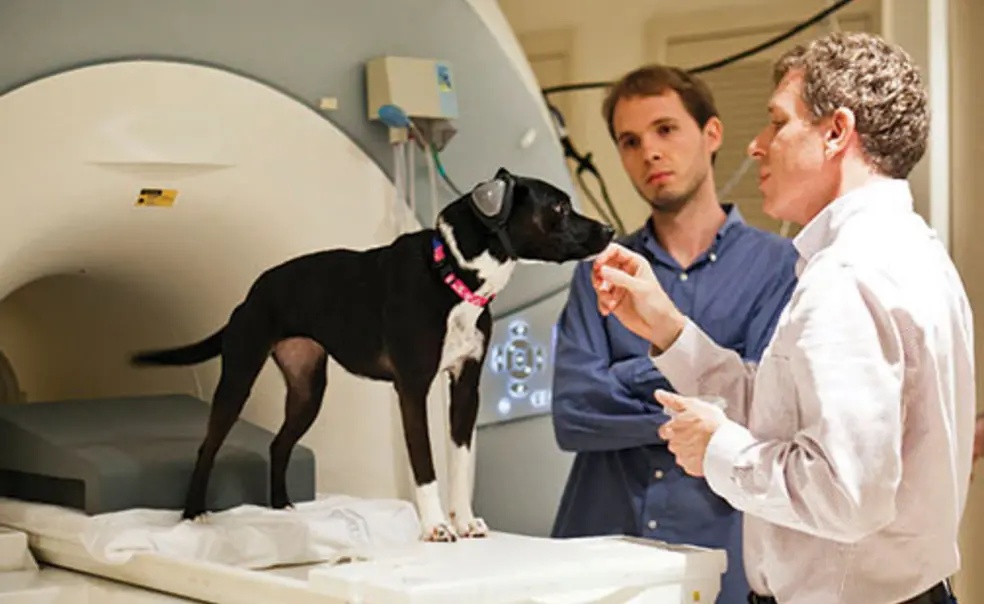Gregory Berns '86: Decoding a Dog's Brain
Humans leave an impression on our four-legged friends — could it be love?
My 9-year-old lab, Butter, loves two things: eating and fetching a tennis ball. I fit in there, too, I suppose, but I’ve always wondered whether she sees me as anything more than a food deliverer and ball tosser. We love our dogs, but do our dogs love us or just what we do for them?
Gregory Berns ’86 believes he has evidence to answer that question. A professor at Emory University, Berns specializes in the emerging field of neuroeconomics, the study of how the human brain makes economic decisions. But for the last two and a half years, when he wasn’t studying human brains, he has been looking at dog brains. He has conducted the first MRI scans of unrestrained, unanesthetized dogs and published his findings in a new book, How Dogs Love Us (New Harvest). He has found what many dog owners always suspected: that our dogs are keenly sensitive to our moods as well as our actions, a sensitivity he believes can be called love.
First, the science: Berns and his assistants trained two dogs — Callie, his adopted terrier, and McKenzie, a border collie — to sit still in an MRI scanner while they watched their owners giving hand signals. One signal meant they got a chunk of hot dog. A different signal meant no reward. Brain scans showed that when they saw the signal for a treat, a part of the brain called the caudate nucleus — which is known to process thinking about reward and motivation in humans and other animals — was activated. This activation indicates that the dogs learned the meaning of the hand signals.
In another experiment, he found that smelling a gauze pad with a familiar human’s scent on it triggered the same sort of brain activity in the caudate, suggesting that the dogs develop positive associations of the humans they live with that can be triggered by both smell and sight, and which persist even when the person isn’t physically present. “[W]e humans make a lasting impression on our dogs,” Berns writes. “We are appreciated.”
Berns’ group also found preliminary evidence in the hot-dog experiment for activity in other regions of the brain associated with memory and movement, both the dog’s own movement and its perception of movement by other animals. Activity in these regions of the brain leads Berns to believe that dogs may be developing their own mental pictures of the people around them. Rather than dogs being mere Pavlovian stimulus-response machines, Berns believes that the brain activity shows that they react to what they think we are thinking.
This suggests that social conditioning — speaking clearly and consistently — may be a better training method for owners than behavioral conditioning, such as rewarding the dog when it responds to signals such as a hand-held clicker device — because dogs are capable of understanding what we want. Furthermore, Berns believes, if dogs really do reciprocate our feelings, it “changes everything” about the dog-human relationship. “It makes it more like our relationship with a human child,” he says.
Berns is working with 13 dogs, trying to answer more questions about how the canine brain works. In addition to his book, he has published his findings as a peer-reviewed article in the journal PLoS ONE and has two more articles in the works. He has received funding from, of all groups, the Navy, which wants to know more about how bomb-sniffing dogs process their environment and how other dogs might be used in therapy for humans suffering from post-traumatic stress disorder.













1 Response
Lucille Kaplan ’75
9 Years AgoResearching Canine Brains
Re “Decoding a Dog’s Brain” (Princetonians, Dec. 4): In a climate in which operant and classical behavioral conditioning have become the gold standard among humane dog trainers, these findings are really eye-popping. There is some intuitive resistance, among certain dog guardians, to the treat/reward/clicker methods that now prevail as operant/classical strategies, even though these methods are impeccably humane and very effective. Could it be that these guardians have some sense that their dogs are understanding their intentions in a way that opens the door to the novel social-conditioning approach suggested here? I can’t wait to see where this research goes. It also is gratifying to see animals employed non-exploitatively, in research designed for ends that benefit the animals themselves.